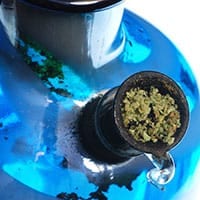Marijuana is the most popular form of a substance called cannabis, which comes from the leaves, flowers, and stems of a group of related plant species. In the past, a number of studies have linked marijuana use to an elevated risk for developing at least some of the symptoms of certain diagnosable mental illnesses. A new large-scale study, published in 2013 in the journal Comprehensive Psychiatry, confirms the link between regular marijuana use and mental health problems, and also provides an increased level of detail regarding the strength of that link.
Marijuana Use Basics
With the exception of alcohol, marijuana is the world’s most popular mind-altering substance, and estimates indicate that more than 200 million people across the globe use the drug. Apart from any connections to specific mental illnesses, marijuana use is a concern because it can trigger the onset of three harmful conditions in the mind/body: intoxication, abuse and dependence. According to guidelines established in the United States by the American Psychiatric Assn., each of these conditions qualifies as a form of substance use disorder. [tc2 img=”//elementsbh.wpengine.netdna-cdn.com/wp-content/uploads/2010/02/dual-lrg-630×280.jpg” title=”Dual Diagnosis Treatment” url=”//elementsbh4.wpengine.com/treatment/dual-diagnosis-treatment/”]Dual diagnosis treatment addresses not only the substance abuse or eating disorder, but the underlying psychiatric diagnosis as well. The goal of dual diagnosis treatment is to help the client develop a clear plan for the future, and where indicated, refer them to clinicians in their home town to continue treatment after discharge. Without comprehensive clinical assessment and focused treatment of the dual diagnosis, the client is at high risk for relapse. Dual diagnosis treatment must be a primary part of the treatment program, not simply an ancillary treatment option.[/tc2] The American Psychiatric Assn. defines intoxication as a reversible state of mind that appears after the use of a substance and produces effects such as mood instability and a decrease in the ability to think clearly or exercise good judgment; collectively, these effects are known as maladaptive (inappropriately adjusted) changes. Abuse occurs when a person starts to engage in a damaging pattern of substance use; indications of such a pattern include recurring involvement in legal problems, repeated participation in such dangerous activities as intoxicated driving, and ongoing disruptions in work, social, or personal relationships. Dependence occurs when a substance user becomes physically reliant on that substance; indications of such a reliance include increasing tolerance to the substance’s effects, a corresponding increase in the amount and/or frequency of substance use, and the development of withdrawal symptoms if substance use stops or declines sharply.
Previous Mental Illness-Related Findings
Previous studies have linked marijuana use to mental illness in one way or another. For example, a study published in 2011 in the Journal of Neuroscience concluded that THC (tetrahydrocannabinol)—the main active ingredient in marijuana—makes changes in two key brain areas that roughly mimic the effects of psychosis, a damaging mental state that produces problems such delusional thinking and hallucinations. In turn, psychosis is one of the classic features of the severe mental illness called schizophrenia. A number of studies reported by the National Institute on Drug Abuse have linked marijuana use in the present to the later development of actual psychosis symptoms. In addition, a study published in 2012 in the journal Frontiers in Psychiatry, concluded that diagnosed schizophrenics who use marijuana have higher levels of brain disorganization than diagnosed schizophrenics who don’t use the drug.
Current Findings
In the study published in Comprehensive Psychiatry, a team of Canadian researchers examined the information contained in more than 43,000 survey responses gathered over the course of a large-scale U.S. project called the National Epidemiologic Survey on Alcohol and Related Conditions. These survey responses contained detailed information on such topics as the participants’ history of marijuana use, drug or alcohol use disorders, major depression, anxiety disorders and personality disorders. After reviewing the data at their disposal, the authors of the study concluded that 4.4 percent of all adults in the U.S. diagnosed with a mental disorder use marijuana on a weekly basis; by comparison, only 0.6 percent of American adults without diagnosed mental illnesses use marijuana this frequently. They also concluded that 4 percent of all adults with a mental illness meet the criteria for a marijuana use disorder (intoxication, abuse or dependence); only 0.4 percent of adults without a mental illness diagnosis meet these same criteria. In addition, the authors of the study concluded that people with certain types of mental illness—including bipolar disorder and several different personality disorders—tend to use marijuana more frequently than people with other types of mental illness.
Considerations
Generally speaking, marijuana use is most common in younger adults. However, the authors of the study in Comprehensive Psychiatry note, the link between marijuana use and mental illness holds true for adults of all ages. One probable reason for the increased use of marijuana in mentally ill people is a desire to escape or ease the symptoms associated with various psychiatric disorders. Unfortunately, in many cases, marijuana use actually worsens those symptoms rather than temporarily improving them.

